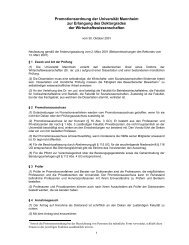The returns to cognitive and non-cognitive abilities in Germany
The returns to cognitive and non-cognitive abilities in Germany
The returns to cognitive and non-cognitive abilities in Germany
You also want an ePaper? Increase the reach of your titles
YUMPU automatically turns print PDFs into web optimized ePapers that Google loves.
ot<strong>to</strong>m or <strong>to</strong>p of the extraversion distribution is associated with wage penalties of roughly<br />
6% (Table 3, column 3), but the coefficients aga<strong>in</strong> turn statistically <strong>in</strong>significant <strong>in</strong> the HTIV<br />
model.<br />
Add<strong>in</strong>g <strong>to</strong> the f<strong>in</strong>d<strong>in</strong>gs above, the results <strong>in</strong> this specification do not contrast a<br />
positive l<strong>in</strong>ear relationship between wages <strong>and</strong> (positive or negative) reciprocity for both<br />
females <strong>and</strong> males, between wages <strong>and</strong> conscientiousness for males, <strong>and</strong> an <strong>in</strong>verse l<strong>in</strong>ear<br />
relationship between workers’ wages <strong>and</strong> agreeableness. While only a few of the coefficients<br />
are statistically significant at the 10%-level <strong>in</strong> the HTIV regressions, the f<strong>in</strong>d<strong>in</strong>gs from both<br />
OLS <strong>and</strong> HTIV estimations <strong>in</strong>dicate some wage effects of FFM traits for males (Table 3,<br />
columns 3 <strong>and</strong> 4). In particular, be<strong>in</strong>g very conscientious relates <strong>to</strong> more than 5% higher<br />
wages, scor<strong>in</strong>g low <strong>in</strong> either positive or negative reciprocity is associated with some 4% <strong>to</strong><br />
6% lower wages, <strong>and</strong> be<strong>in</strong>g very extraverted comes with a wage penalty of about 6%.<br />
[Table 3 about here]<br />
Beyond that, the most robust f<strong>in</strong>d<strong>in</strong>g <strong>in</strong> these specifications is aga<strong>in</strong> found for<br />
<strong>in</strong>dividuals’ external locus of control. Re<strong>in</strong>forc<strong>in</strong>g the results above, the coefficients <strong>in</strong>dicate<br />
an <strong>in</strong>verse relation with wages of both males <strong>and</strong> females so that an <strong>in</strong>crease from the bot<strong>to</strong>m<br />
25% <strong>to</strong> the <strong>to</strong>p 25% would be associated with a wage <strong>in</strong>crease of some 17% for females <strong>and</strong><br />
more than 20% for males (Table 3, columns 2 <strong>and</strong> 4). As for <strong>in</strong>dividuals’ <strong>cognitive</strong> <strong>abilities</strong>,<br />
we f<strong>in</strong>d a hump-shaped relationship between females’ wages <strong>and</strong> SCT <strong>and</strong> a positive l<strong>in</strong>ear<br />
relationship <strong>to</strong> males’ wages. Statistical significance or rather the lack thereof is however<br />
aga<strong>in</strong> an issue here <strong>in</strong>asmuch as the coefficients for scor<strong>in</strong>g <strong>in</strong> the bot<strong>to</strong>m 25% are<br />
statistically different from zero only <strong>in</strong> the pooled OLS models, imply<strong>in</strong>g a wage differential<br />
of about 4%.<br />
24















